Exploring Yellowish Orange Crystals: Properties and Uses
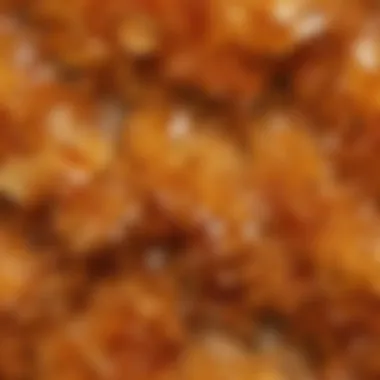
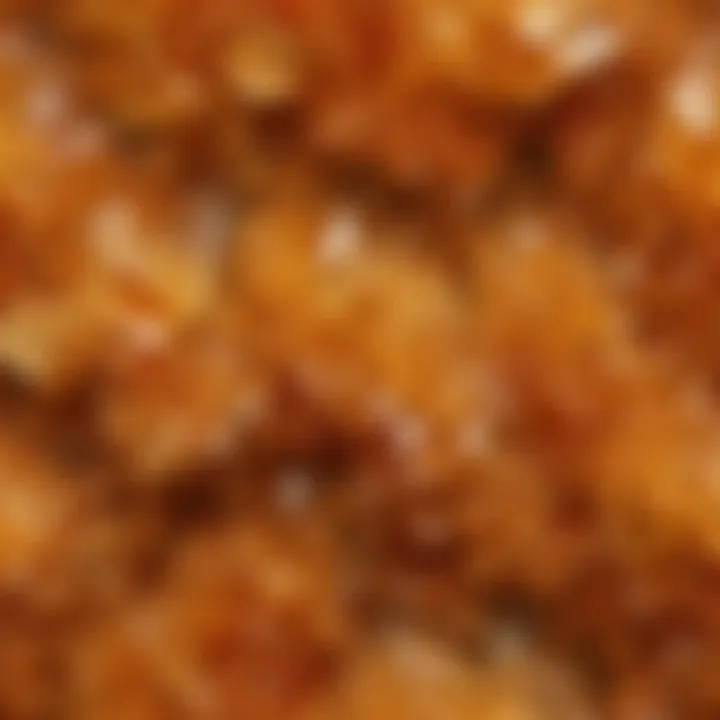
Intro
Yellowish orange crystals often catch the eye of collectors and enthusiasts alike. Their unique color can evoke intrigue and wonder. These crystals are not just aesthetically pleasing; they possess distinct physical and chemical properties that make them worthy of study. Understanding these properties is essential for accurate identification and applications across various fields.
In this article, we will explore the fascinating world of yellowish orange crystals. We will focus on their geological formation, identification techniques, and substantial applications in both natural and synthetic contexts. This exploration serves to provide a resource for hobbyists, collectors, and scientific communities. By presenting case studies and notable examples, we aim to underscore the significance these crystals hold in geology and mineralogy.
Preamble to Yellowish Orange Crystals
The study of yellowish orange crystals draws considerable interest among mineralogists, collectors, and enthusiasts alike. Understanding these unique mineral specimens provides insights into the physical and chemical properties of different types of crystals. These characteristics not only assist in identification but also influence their applications in both natural and synthetic contexts.
Identifying yellowish orange crystals can be a challenging task. Their hues can vary widely, complicating visual identification. Associating different crystals with their properties allows collectors to distinguish between them effectively. This section introduces fundamental aspects of yellowish orange crystals, forming a basis for deeper exploration.
Definition and Overview
Yellowish orange crystals refer to a variety of crystalline minerals that display shades ranging from pale yellow to deep orange. These colors result from the presence of specific trace elements and their interactions within the crystal structure. Notable examples include amber, citrine, and tiger's eye.
Each type exhibits unique attributes, which can affect its value and desirability among collectors. For example, citrine is known for its vibrant golden hues, while amber is admired for its organic origins and inclusions. An accurate definition and overview set the stage for understanding how these crystals form, evolve, and can be utilized in various fields.
Historical Context
The historical significance of yellowish orange crystals spans cultures and epochs. Throughout history, certain yellowish orange minerals have been esteemed for their beauty, utility, and symbolic meanings. In ancient times, amber was often used in jewelry and rituals, valued for its warmth and organic nature.
Similarly, citrine has been regarded as a stone of prosperity in various civilizations. Its exhibition of light has made it a sought-after gemstone, and its associations with wealth and success create a rich narrative within the fields of history and gemology. Understanding the past context is crucial, as it influences current appreciation and valuation of these crystals.
The cultural and historical implications of yellowish orange crystals deepen our understanding of their significance beyond mere aesthetics.
Delving into these aspects provides valuable insights for rock and fossil collectors, enhancing their knowledge base and appreciation for these fascinating minerals.
Physical Properties of Yellowish Orange Crystals
The physical properties of yellowish orange crystals are vital not only for their identification but also for their applications in various fields. These properties include aspects like color, structure, and durability. Each attribute contributes to the unique nature of the crystals and informs how they might be used, appreciated, or studied.
Color and Appearance
The color of yellowish orange crystals is one of their most distinctive features. The shades can vary significantly, ranging from pale yellow to deep amber. This variation in hue can indicate the presence of different trace elements. For example, the presence of iron can deepen the color, while inclusions may create unique patterns or transparency.
- Clarity: Some crystals may be completely transparent, while others may have inclusions that alter their appearance.
- Luster: These crystals can boast a glassy, resinous, or dull luster, influencing their visual appeal.
The aesthetic qualities are integral in fields like jewelry and art. Collectors often seek specimens not just for their scientific value but also for their beauty. As such, an understanding of color and appearance is essential for appraising these crystals accurately.
Crystal Structure
Crystal structure pertains to the arrangement of atoms within the mineral, which directly influences its physical properties. Many yellowish orange crystals exhibit different forms of crystallization, such as hexagonal, trigonal, or orthorhombic systems. The symmetry and geometric arrangements play a significant role in determining how the crystal interacts with light and other materials.
Different structures also suggest different formation conditions and environments. For instance, the crystalline form of citrine often indicates formation in hydrothermal settings, whereas amber is typically organic in nature, derived from fossilized tree resin.
Understanding crystal structure is crucial for both mineral identification and the manufacturing of synthetic versions in industries.
Hardness and Durability
The hardness and durability of yellowish orange crystals are significant factors determining their uses. The Mohs scale, which ranks minerals from 1 to 10 based on scratch resistance, helps categorize these crystals. For example, citrine ranks around 7 on the Mohs scale, indicating it is moderately hard and suitable for everyday jewelry. In contrast, amber is softer, at about 2 to 2.5, which necessitates careful handling.
Durability also relates to how well the crystal can withstand environmental factors such as moisture, temperature changes, and physical impacts. Harder crystals are often preferred in industrial applications due to their resilience.
- Applications in Jewelry: Durability influences the suitability of a crystal as a gemstone. Harder gemstones can be set into rings and bracelets, whereas softer minerals may be better suited for pendants.
- Retention of Value: Higher hardness often correlates with better value retention in collectibles.
In summary, an in-depth understanding of the physical properties of yellowish orange crystals is crucial. This knowledge helps in identification and ensures proper applications in various domains, from scientific research to aesthetic use.
Chemical Composition
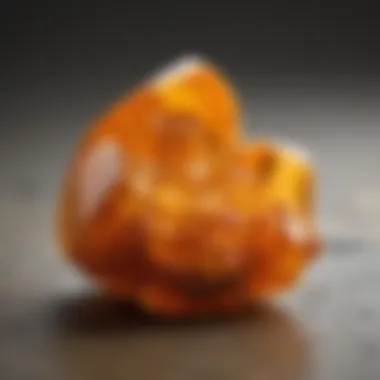
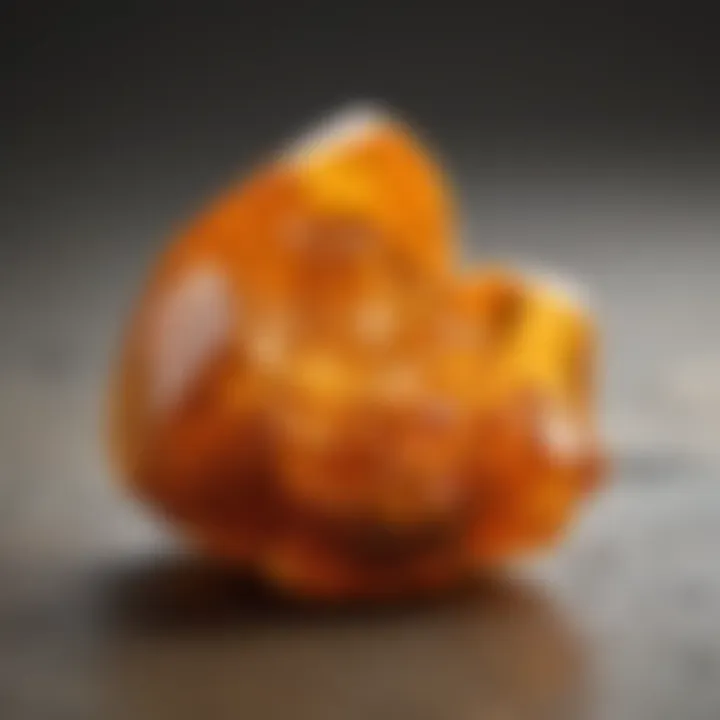
Chemical composition of yellowish orange crystals is an essential aspect that serves as a baseline for understanding these minerals. Each type of crystal is defined by its unique arrangement of atoms, which in turn determines its physical properties, behavior under various conditions, and potential applications. Recognizing this composition allows a collector or enthusiast to differentiate between types, make informed decisions while acquiring specimens, and appreciate their intrinsic value.
Common Elements and Compounds
In the world of yellowish orange crystals, specific elements are prevalent, contributing to their distinct color and structure. Silica is one of the most common components, found in variants like Citrine. This mineral, a form of quartz, contains iron traces that yield its characteristic yellow hue. Amber, another notable example, primarily comprises fossilized tree resin, with organic compounds like succinic acid.
Furthermore, Tiger's Eye contains silicate minerals, which exhibit a unique chatoyancy effect, creating a silky luster. Other elements that may be present include calcium, sodium, and aluminum, contributing to the variety in mineral formation and characteristics. Understanding these common elements is crucial for identifying and classifying specimens accurately.
Variations in Composition
Variations in chemical composition are not just an academic interest; they impact practical applications and the collector's experience. For example, the presence of impurities or the ratio of elements can alter physical traits such as transparency, hardness, and durability. Citrine, while mostly silica, can vary in its iron content, affecting its shade from light yellow to deep orange. Similarly, Amber can contain numerous inclusions, including air bubbles or ancient plant material, which can enhance its value and story.
Collectively, these differences highlight why understanding the chemical composition is vital for anyone engaged in collecting, studying, or utilizing yellowish orange crystals. This knowledge can inform decisions in purchase, preservation, and overall appreciation of these geological marvels.
"Knowledge of composition allows collectors to appreciate the depth and variability in each specimen, enhancing their value and significance."
By grasping both common elements and variations in composition of yellowish orange crystals, enthusiasts can deepen their knowledge and expertise. This familiarity with chemical landscapes enriches engagement with the field, fostering a community of informed rock and fossil collectors who share a passion for these stunning natural creations.
Geological Formation of Yellowish Orange Crystals
The geological formation of yellowish orange crystals involves a variety of processes that contribute to their unique characteristics and distribution. Understanding these processes is essential for collectors and enthusiasts, as it helps in identifying not just the crystals but also their potential sources. The formation of these crystals is influenced by factors such as temperature, pressure, and chemical environment, which collectively shape their final appearance and qualities.
Formation Processes
Yellowish orange crystals form through several geological processes, primarily involving crystallization from molten rock, metamorphic transformations, or precipitation from mineral-rich solutions. Each of these processes has distinct implications for the properties of the resulting crystals.
- Magmatic Processes: In this process, yellowish orange crystals like citrine can form as magma cools slowly beneath the Earth’s surface. As the molten rock solidifies, elements crystallize and bond together, forming minerals. For instance, citrine, a variety of quartz, can develop through the cooling of silica-rich magma.
- Metamorphic Processes: During metamorphism, existing minerals can undergo changes due to increased temperature and pressure. This can lead to the formation of new yellowish orange minerals. For example, the conditions cause existing quartz to absorb other elements, transforming it into a different type of quartz with a distinct color.
- Hydrothermal Processes: In hydrothermal environments, mineral-laden hot water can deposit yellowish orange crystals in cavities and fissures. This often results in gems like Tiger's Eye, where silica deposits create bands of color within the crystal. These deposits can also occur in volcanic regions or near hot springs, where minerals dissolving in the hot water eventually crystallize when conditions change.
Understanding these formation processes not only enriches the knowledge of geology but also informs collectors about where they might find these crystals and what geological conditions favor their formation.
Depositional Environments
The depositional environments play a crucial role in the crystallization and development of yellowish orange crystals. These crystals can be found in various geological settings, each contributing to their formation in unique ways.
- Sedimentary Environments: In riverbeds or ocean floors, minerals can accumulate and gradually undergo processes that lead to the formation of yellowish orange crystals. Over time, sedimentation can trap minerals like amber, which is a fossilized tree resin.
- Volcanic Environments: The cooling lava and associated volcanic activity often create conditions suitable for producing yellowish orange crystals. Volcanic eruptions release gases and minerals that, upon cooling, can crystallize into visible structures.
- Metamorphic Environments: Regions that undergo significant geological stress may exhibit yellowish orange crystals resulting from the transformation of existing minerals. This can occur in mountain-building regions where rocks are subjected to extreme heat and pressure.
Understanding the depositional environments allows rock and fossil collectors to predict where yellowish orange crystals might be located, enhancing their chances of successful discoveries.
Identification Techniques
Identifying yellowish orange crystals is crucial for collectors, jewelers, and scientists alike. Precise identification enables proper classification, ensures appropriate use in applications, and enhances understanding of these crystals' properties. This section lays out various methods used to identify these minerals effectively, focusing on visual cues, optical properties, and advanced analytical techniques. Each method offers unique benefits but also has limitations.
Visual Identification
Visual identification relies on the observable features of a crystal. Color, luster, and texture represent initial indicators in determining the type of crystal.
- Color: Yellowish orange can vary in hue, influenced by impurities. Anything from citrine to amber presents different shades.
- Luster: Real crystals may appear vitreous, resinous, or even dull. Recognizing luster helps distinguish between similar-looking materials.
- Crystal formations: Unique structural shapes can be clues. For instance, tiger's eye often displays a fibrous structure, while citrine has a more uniform crystalline shape.
However, one should remember that visual inspection is sometimes misleading. Often, the same color manifests in different minerals, making it essential to use visual identification as a first step rather than a conclusive measure.
Use of Optical Properties
The optical properties of crystals significantly assist in their identification. These properties include refractive index, birefringence, and pleochroism.
- Refractive Index (RI): Every mineral has a specific RI. This property helps determine how light bends when passing through the crystal. Calculating RI requires specialized instruments, but certain online databases provide reference values for comparison.
- Birefringence: Some minerals exhibit double refraction where light splits into two rays. Confirming birefringence can narrow down identification options significantly.
- Pleochroism: This effect describes how a crystal changes color when viewed from different angles. Amber often displays this property, especially under polarized light techniques.
These optical tests are potent tools that can enhance the accuracy of identification, especially for those who might confuse one crystal type with another.
Advanced Analytical Methods
For a more definitive identification, advanced analytical methods can provide crystal characteristics beyond the eye's capabilities. These techniques typically require specialized tools or professional assistance.
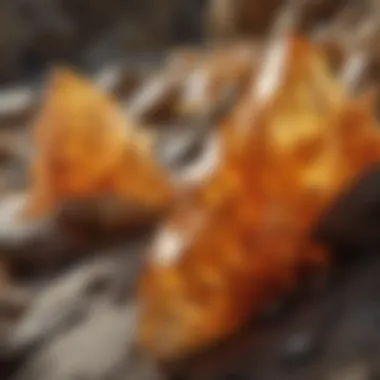
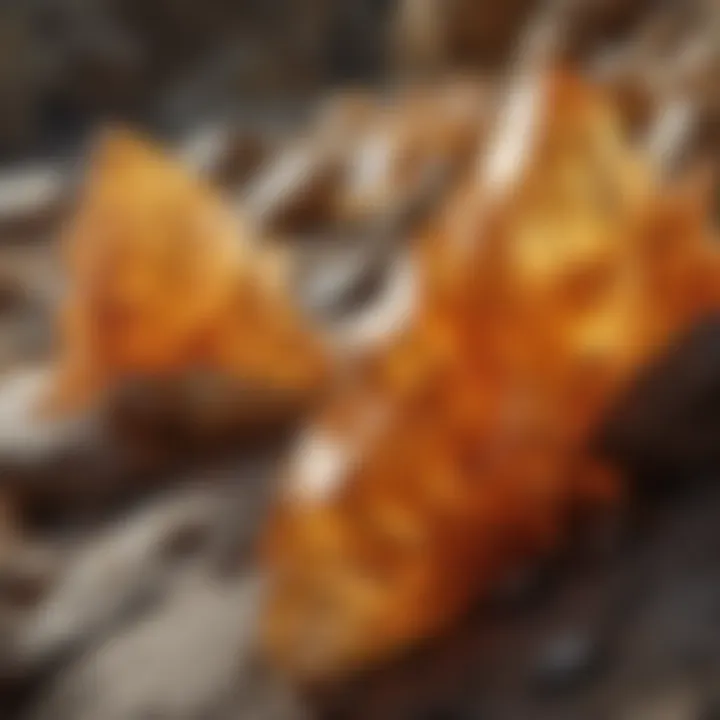
- X-Ray Diffraction (XRD): This method provides detailed information on crystal structure. By measuring the angles and intensities of scattered X-rays, it creates a unique pattern that can identify the mineral.
- Scanning Electron Microscopy (SEM): SEM reveals surface details. It can analyze crystal morphology and elemental composition with high resolution.
- Fourier Transform Infrared Spectroscopy (FTIR): FTIR evaluates the chemical bonds within a crystal. By measuring infrared light absorption, this technique identifies certain functional groups present in the crystal, aiding in identifying its chemical nature.
These advanced methods often prove vital for researchers and serious collectors who require precise data.
In summary, identification techniques serve as a foundation for understanding yellowish orange crystals. Using visual cues as a starting point, one can enhance reliability through optical and analytical methods. Each technique has specific contexts and should be applied according to the resources and needs of the user.
Notable Examples of Yellowish Orange Crystals
The study of yellowish orange crystals would not be complete without highlighting specific notable examples. These minerals exhibit unique features that not only distinguish them but also demonstrate the various applications they serve. Understanding these examples can be beneficial for rock and fossil collectors, as it frames the context in which yellowish orange crystals can be appreciated and identified.
Amber
Amber is likely the most recognized yellowish orange crystal, famous for its captivating beauty and intricate history. This fossilized tree resin often contains inclusions of ancient organisms, which add to its appeal and scientific value. Collectors prize amber for both its aesthetic qualities, displayed in jewelry, and its geological significance, as it provides insights into ancient ecosystems.
In its pure form, amber can display a range of hues from deep yellow to a rich golden orange. Its transparency, combined with the ability to encapsulate organic matter, makes it a key specimen in understanding past biodiversity. Furthermore, amber has long been valued in various cultural contexts, representing authenticity and longevity due to its preservation of life forms.
Citrine
Citrine is another important yellowish orange crystal renowned for its vibrancy and economic value. As a variety of quartz, it brings a distinct sunny aspect to any collection. Unlike other yellowish stones, citrine's availability and affordability make it popular among both casual collectors and serious enthusiasts. When cut and polished, citrine exhibits a brilliant luster, often being used in ornaments and jewelry designs.
The origins of citrine are also notable, as natural deposits are found in several locations around the world, including Brazil and Madagascar. Its color ranges from pale yellow to a deeper orange, often influenced by trace elements present during formation. This makes citrine not only visually appealing but also scientifically interesting, as it showcases the relationship between composition and coloration.
Tiger's Eye
Tiger's Eye stands out as a yellowish orange crystal that captivates many with its unique appearance. Characterized by its chatoyancy, or cat's eye effect, it exhibits a silky luster and bands of golden to reddish-brown hues. This stone is formed from the alteration of crocidolite, and its distinct patterns arise from the fibrous structure of its minerals.
In terms of application, Tiger's Eye is often cut into cabochons for jewelry. It is believed to possess metaphysical properties, including grounding and protective attributes, which may attract collectors interested in holistic practices. Its durability and fascinating aesthetics enhance its importance in jewelry making and mineral collections alike, making it a significant example in the realm of yellowish orange crystals.
Applications of Yellowish Orange Crystals
The applications of yellowish orange crystals extend widely across various fields, showcasing their versatility and significance. These crystals are not merely aesthetically pleasing; they also hold practical value in numerous domains ranging from art to science. Understanding these applications helps to appreciate the true importance of these minerals in both contemporary and historical contexts. In this section, we will explore their roles in jewelry, industry, and culture.
In Jewelry and Ornamentation
Yellowish orange crystals are treasured in the jewelry industry. They are often used in making statement pieces due to their vibrant hue and intrinsic beauty. Amber, famed for its golden tones, is a popular choice, often set in silver or gold to enhance its visual appeal. The warm colors of citrine and tiger's eye bring a unique aesthetic to accessories, allowing for a wide range of designs from elegant to bold.
Consumers value these crystals not just for their appearance but also for their perceived metaphysical properties. Many believe that citrine promotes happiness and prosperity, which boosts its demand in jewelry.
The market for yellowish orange crystals also includes custom crafts and artisanal jewelry, giving individual artists the chance to create unique pieces that reflect personal stories or heritage.
Key considerations in this application include:
- Market Demand: The popularity of certain stones can fluctuate based on trends.
- Sourcing: Ethical sourcing of materials is crucial in today’s market to ensure environmental sustainability.
In Science and Industry
In scientific sectors, yellowish orange crystals have applications that extend beyond aesthetics. For instance, minerals like citrine are utilized in varous industrial processes because of their optical properties. These crystals can be used in lasers and other optical devices.
Moreover, researchers study the chemical and physical properties of these minerals for their potential uses in technology and energy sectors. Yellowish orange crystals can also be indicators of specific geological processes, thus aiding in research and exploration in mining and geology.
Specific applications in science and industry include:
- Optical Devices: Utilization in lasers and filters.
- Geological Research: Indicators of processes within the Earth’s crust.
- Therapeutic Applications: Some research is exploring the use of these minerals in healing practices.
In Cultural and Historical Contexts
The cultural significance of yellowish orange crystals is profound. Historically, amber has been used in jewelry for thousands of years and holds considerable value in ancient cultures. Its beauty is esteemed in many societies, often symbolizing life and vitality.
In various cultures, these crystals are believed to possess various properties, from protective qualities to symbols of wealth and fortune. For instance, tiger's eye is thought by some to provide clarity and strength.
Factors of interest in this area include:
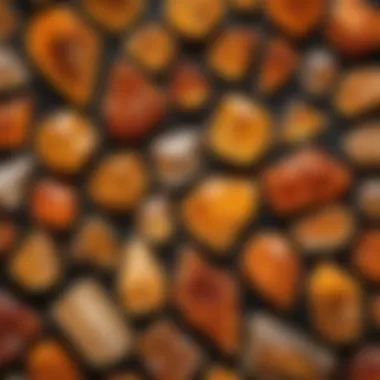
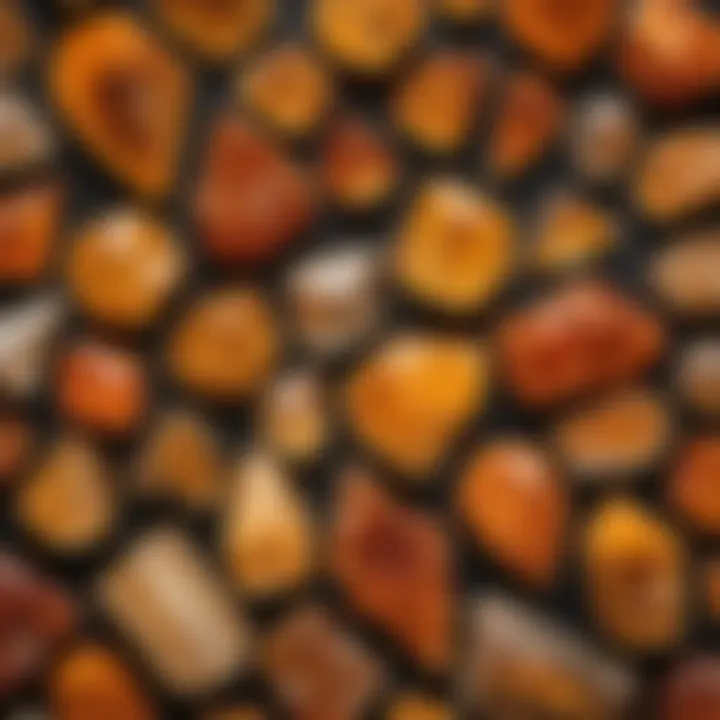
- Symbolism: The meanings attributed to different stones can influence their use in customs and traditions.
- Cultural Heritage: Many yellowish orange crystals are central to the identity and heritage of specific groups, linking them to ancient practices.
The study of yellowish orange crystals reveals not only their physical characteristics but also their significance in human history and culture, providing insights into how societies perceive and utilize natural resources.
Collecting and Preservation
Collecting yellowish orange crystals presents an opportunity for enthusiasts to engage with the beauty and diversity of nature's creations. The act of collecting goes beyond mere acquisition; it involves understanding the significance of each specimen, the geological context from which it originates, and its unique properties. Proper preservation is equally crucial. Without adequate care, these crystals can deteriorate over time, losing their charm and value.
In addition, well-preserved specimens can serve as valuable educational tools and inspire a deeper appreciation for geology and mineralogy. Collectors must consider various factors while handling and storing these crystals, ensuring they retain both aesthetic and scientific value.
Techniques for Collecting
When it comes to collecting yellowish orange crystals, there are several techniques that enthusiasts should consider:
- Field Collecting: Venturing into natural environments where these crystals are likely to be found is essential. Research geological maps and reports to identify locations with known deposits.
- Safety Precautions: Always prioritize safety. Wear appropriate gear, such as gloves and boots, when collecting. Be aware of your surroundings, especially in remote areas.
- Tools and Equipment: Common tools include hammers, chisels, and brushes. Use them carefully to extract crystals without causing damage.
- Documentation: Keeping notes about the location, conditions, and any observations will enrich your collection history. Photographs can also enhance your records.
Preservation Methods
Once collected, yellowish orange crystals require specific preservation methods to maintain their integrity:
- Proper Cleaning: Before preservation, gently clean the crystals using distilled water and a soft brush to remove dirt and debris. Avoid harsh chemicals that can cause discoloration.
- Control of Environment: Store crystals in a stable environment with controlled temperature and humidity levels. Excessive fluctuations can lead to damage.
- Storage Solutions: Utilize display cases or acid-free containers to keep your crystals safe. Ensure they are not in direct sunlight, as UV rays can fade colors.
- Regular Inspection: Periodically check your collection for signs of deterioration. Early detection of any flaws can prevent further damage.
"Collecting is not just about ownership; it’s about stewardship and respect for the natural world."
By adopting suitable collecting techniques and preservation methods, enthusiasts can enjoy their yellowish orange crystals for many years. Whether for personal enjoyment or scientific inquiry, understanding the collection process is key to sustaining the beauty and significance of these remarkable minerals.
Challenges in the Study of Yellowish Orange Crystals
The study of yellowish orange crystals presents a unique set of challenges that can hinder proper identification and appreciation of these minerals. Understanding these obstacles is essential for collectors, researchers, and hobbyists alike, as they navigate the complexities surrounding these fascinating specimens. The main challenges include difficulties in identification, environmental concerns, and a lack of comprehensive information available to the community.
Identification Difficulties
The identification of yellowish orange crystals can be complex. Several similar-looking minerals exist within this color spectrum, making accurate identification challenging. For instance, Citrine, Amber, and Tiger's Eye can often be mistaken for one another. Each of these minerals has distinct properties, but their visual similarities can confuse both novice and seasoned collectors.
Factors contributing to identification difficulties include:
- Variability in Color: The exact shade of yellow-orange can vary significantly from sample to sample, influenced by impurities and internal structures.
- Lack of Distinctive Features: Some yellowish orange crystals do not have clear, observable features that differentiate them from similar minerals. This lack of unique characteristics can complicate internet-based identification efforts.
- Microscopic Analysis: A detailed analysis often requires specialized equipment. Many collectors do not have access to advanced tools, such as a scanning electron microscope (SEM), which would help in determining mineral composition and crystalline structure.
These factors pose significant hurdles in the field. Consequently, proper identification may require consultation with experts or reliance on laboratory analysis.
Environmental Concerns
Environmental issues are increasingly relevant in the study of yellowish orange crystals. Extracting minerals can lead to detrimental effects on their natural surroundings. Responsible collecting practices are crucial, as over-extraction can threaten local ecosystems. Some specific concerns include:
- Habitat Disruption: Mining and collection activities can disrupt delicate ecosystems, affecting local flora and fauna.
- Erosion: The removal of crystals and minerals from their natural environment may accelerate erosion, leading to long-term geological changes.
- Sustainable Practices: There is an increasing necessity for sustainable collecting practices. Educating collectors about these practices can mitigate environmental impacts, ensuring that yellowish orange crystals are accessible for future generations.
In recognizing these challenges, the crystal collecting community can foster a more sustainable approach, ensuring the careful preservation of both the crystals themselves and their environments.
By addressing identification difficulties and environmental concerns, the study of yellowish orange crystals can develop further ways to appreciate these distinctive minerals while protecting their ecosystems.
End and Future Research Directions
The exploration of yellowish orange crystals offers valuable insights into both their unique composition and the underlying processes that shape their formation. These crystals possess a multitude of properties that have been extensively discussed throughout this article. Their physical and chemical characteristics, along with the methods used for identification, reveal significant information not only for collectors but also for scientists and enthusiasts in geology and mineralogy. Understanding these crystals emphasizes their importance in various applications, including jewelry, industrial uses, and scientific research.
Summary of Findings
The findings on yellowish orange crystals indicate that they are not merely aesthetically pleasing but also have profound implications across different fields of study. Crystals such as Amber, Citrine, and Tiger's Eye serve as prime examples that showcase the wide variety of properties these minerals can exhibit. The investigations into their properties have highlighted factors like their durability, optical characteristics, and mechanisms of formation. The discussion on collecting and preservation techniques has underscored the need for responsible practices in maintaining these specimens for future study and enjoyment.
The challenges faced in accurately identifying these crystals, as well as the environmental concerns related to their extraction, point to areas where further research is essential. Researchers must embrace more sophisticated methods for analysis and identification. This effort will not only safeguard the integrity of collections but also enhance our understanding of these crystals overall.
Potential Areas for Further Study
There are several critical areas that merit deeper investigation:
- Advanced Analytical Techniques: Utilizing cutting-edge technology such as X-ray diffraction and Raman spectroscopy can yield better insights into the molecular structure and elemental composition of these crystals.
- Environmental Impacts: Research on the environmental impacts of mining and collecting practices can help develop sustainable methods that protect both the crystals and their habitats.
- Cultural Significance: Exploring the cultural contexts of yellowish orange crystals, including their roles in different societies, can reveal much about human interaction with these natural resources.
- Market Trends: Analysis of the gemstone market's fluctuating values can provide insight into economic factors that affect the collecting community, assisting collectors and retailers alike.
The exploration of yellowish orange crystals is an ongoing journey. The increasing interest in these minerals presents opportunities for both academic research and practical applications. As we continue to uncover their mysteries, these unique crystals can offer even more insights into our natural world.



